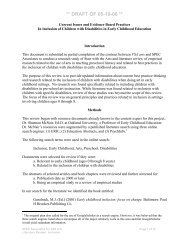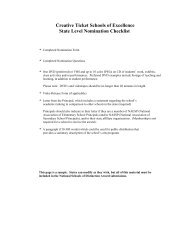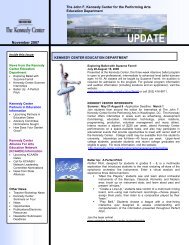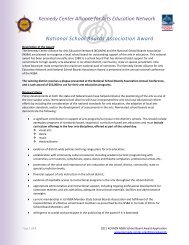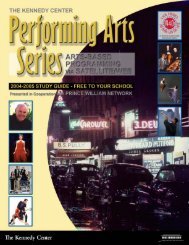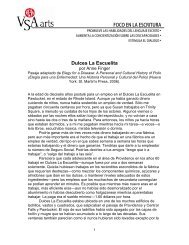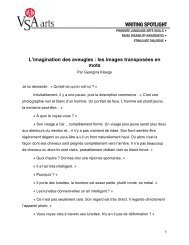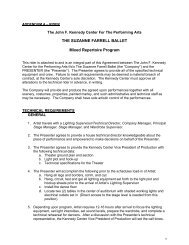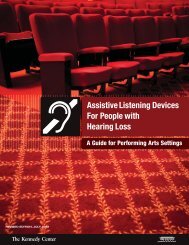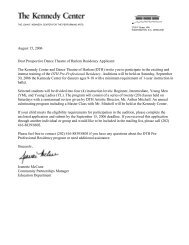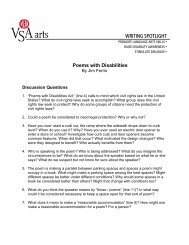to download the study guide for this program - The John F. Kennedy ...
to download the study guide for this program - The John F. Kennedy ...
to download the study guide for this program - The John F. Kennedy ...
Create successful ePaper yourself
Turn your PDF publications into a flip-book with our unique Google optimized e-Paper software.
THE KENNEDY CENTER<br />
Stefon Harris and Blackout<br />
Friday, December 18, 2009<br />
11a.m.-12 p.m. ET<br />
Grades 4-8<br />
Curriculum Connections: American His<strong>to</strong>ry<br />
National Standards <strong>for</strong> Music: 6, 7, 8, 9.<br />
About <strong>the</strong> Program<br />
During <strong>this</strong> session, vibraphonist-composer Stefon<br />
Harris along with his band Blackout teaches<br />
Jazz: An Evolving Art Form<br />
Stefon Harris (vibraphone, marimba), Marc Cary<br />
(piano), Ben Williams (bass), Casey Benjamin<br />
(saxophone) and Terreon Gully (drums).<br />
students what <strong>to</strong> listen <strong>for</strong> in jazz. Heralded as "one of <strong>the</strong> most important young artists in<br />
jazz" (Los Angeles Times), Harris leads students through a series of listening exercises as <strong>the</strong><br />
ensemble demonstrates <strong>the</strong>ir eclectic sound—a hybrid of acoustic music and progressive<br />
sounds. In <strong>this</strong> <strong>program</strong>, students develop a heightened awareness <strong>for</strong> jazz music while<br />
learning <strong>the</strong> art of active listening and how <strong>to</strong> interpret music.<br />
Jazz is a truly American musical <strong>for</strong>m—and many people consider it one of America’s best<br />
contributions <strong>to</strong> <strong>the</strong> world of music. Jazz first emerged about 100 years ago in <strong>the</strong> American<br />
south, most distinctly in New Orleans, Louisiana. This seaport city served as home <strong>to</strong> people<br />
of African, French, English, Caribbean, and o<strong>the</strong>r backgrounds. It became a melting pot <strong>for</strong><br />
music from many traditions as well. Black musicians fused elements of ragtime, blues,<br />
classical, and big brass band sounds <strong>to</strong> create a distinct new type of music—jazz.<br />
After <strong>the</strong> first jazz recordings were made in 1917, jazz spread across <strong>the</strong> nation. It also evolved<br />
over <strong>the</strong> decades, helped along by influential musicians. Among <strong>the</strong>m, trumpeter Louis<br />
Armstrong (1920s) introduced improvised solos; Duke Elling<strong>to</strong>n (1920s) popularized big<br />
band jazz; Charlie Parker (1940s) broke ground with a faster style called bebop; Miles Davis<br />
(1950s) influenced jazz first with his softer, complex “cool” style and later in <strong>the</strong> late 1960s<br />
with fusion jazz; and <strong>John</strong> Coltrane (1960s) helped pioneer using sounds derived from<br />
half-steps, called modal jazz.<br />
Since <strong>the</strong>n, artists—including Stefon Harris and Blackout—have continued <strong>to</strong> explore and<br />
expand <strong>the</strong> musical genre<br />
About Stefon Harris and Blackout<br />
♪ Harris, from upstate New York, has been interested in music since childhood (he tried<br />
playing by ear with television car<strong>to</strong>ons like <strong>The</strong> Pink Pan<strong>the</strong>r).<br />
♪ Although he can play almost every instrument, Harris chose <strong>to</strong> specialize on <strong>the</strong><br />
vibraphone after a percussion-playing men<strong>to</strong>r inspired him.<br />
♪ For Harris, <strong>the</strong> real tradition of jazz comes from au<strong>the</strong>nticity and spontaneity—creating<br />
music that reflects what’s happening right now.<br />
♪ Radiohead, Stravinsky, and Stevie Wonder—how’s that <strong>for</strong> diversity?—have all influenced<br />
Harris’ work.<br />
♪ All <strong>the</strong> Blackout members help write or arrange songs on <strong>the</strong>ir albums.<br />
♪ Blackout member Ben Williams grew up in Washing<strong>to</strong>n, D.C., where he played in local go-go<br />
bands, one of <strong>the</strong> musical influences you can hear in <strong>the</strong> band’s music.
About Stefon Harris and Blackout, cont.<br />
♪ Saxophonist Casey Benjamin also plays <strong>the</strong> vocoder (<strong>the</strong><br />
abbreviation <strong>for</strong> voice encoder), an electronic device that alters <strong>the</strong><br />
voice—think Star Wars’ Darth Vader.<br />
♪ Harris has earned three Grammy nominations (one of music’s<br />
highest honors).<br />
Jazz: What <strong>to</strong> Listen and Look For<br />
Improvisation—creating music or song<br />
spontaneously, a technique that requires great<br />
musical skill and creativity. Listen carefully<br />
<strong>to</strong> <strong>the</strong> melody at <strong>the</strong> beginning of a piece.<br />
This is usually <strong>the</strong> musical material that will<br />
be repeated, developed, and extended<br />
throughout <strong>the</strong> work. Listen carefully when<br />
musicians are playing solos, during which <strong>the</strong>y<br />
often improvise. Try <strong>to</strong> follow <strong>the</strong> solo from<br />
beginning <strong>to</strong> end, and hear how <strong>the</strong> solo differs<br />
from <strong>the</strong> basic melody.<br />
Tempo—<strong>the</strong> speed of <strong>the</strong> music. Are individual<br />
pieces consistently fast or slow throughout, or<br />
does <strong>the</strong> tempo change in certain sections of <strong>the</strong><br />
music?<br />
Syncopation—stressing a note in an<br />
unexpected place, between beats, or on a weak<br />
Instructional Activities<br />
Instrumental jazz is musical conversation without words. During <strong>the</strong> <strong>program</strong>, Stefon Harris<br />
uses nonsense syllables <strong>to</strong> communicate with his band members <strong>to</strong> demonstrate how his<br />
ensemble interacts when playing. In <strong>this</strong> activity communication will occur through improvised<br />
sound. Divide <strong>the</strong> class in<strong>to</strong> small groups of 2, 3 or 4 students. Prior <strong>to</strong> <strong>the</strong> exercise, <strong>the</strong><br />
instruc<strong>to</strong>r creates a list of possible scenarios and characters <strong>for</strong> <strong>the</strong> students <strong>to</strong> improvise. For<br />
example, a student wants <strong>to</strong> convince his dad <strong>to</strong> give him <strong>the</strong> keys <strong>to</strong> <strong>the</strong> car. Or, a student<br />
wants a teacher <strong>to</strong> change a grade on a test. Each group will use nonsense syllables, rhythms,<br />
and o<strong>the</strong>r non-verbal sounds or gestures <strong>to</strong> act our <strong>the</strong>ir scene. After <strong>the</strong> scene, see if <strong>the</strong> o<strong>the</strong>r<br />
students can guess what <strong>the</strong> conversation was about.<br />
Resources<br />
Internet Resources:<br />
His<strong>to</strong>ry of Jazz: artsedge.kennedy-center.org/jazzintime<br />
Jazz in DC: artsedge.kennedy-center.org/jazzindc<br />
Stefon Harris & Blackout: www.stefonharris.com<br />
Rhythm—music made up of strong and soft<br />
beats played in a repeating pattern. Move your<br />
hands and feet <strong>to</strong> <strong>the</strong> different rhythms of each<br />
instrument. Listen <strong>for</strong> how <strong>the</strong> bass player<br />
and drummer keep <strong>the</strong> pulse of <strong>the</strong> music.<br />
Soloing—when a musician per<strong>for</strong>ms<br />
alone. <strong>The</strong> musician’s individual personality is<br />
reflected when musicians create a unique,<br />
personal sound while playing <strong>the</strong>ir<br />
instruments.<br />
Ensemble—refers <strong>to</strong> <strong>the</strong> way musicians in<br />
a group like Blackout work <strong>to</strong>ge<strong>the</strong>r.<br />
Observe how <strong>the</strong> musicians communicate<br />
with one ano<strong>the</strong>r, physically and musically.<br />
Do <strong>the</strong>y exchange glances? Follow <strong>the</strong><br />
players as <strong>the</strong>y alternate taking <strong>the</strong> “lead.”<br />
Select Recordings:<br />
Stefon Harris & Blackout. Urbanus. (Concord Records, Beverly Hills) 2009.<br />
Stefon Harris & Blackout. Evolution. (Blue Note Records, New York ) 2004.



